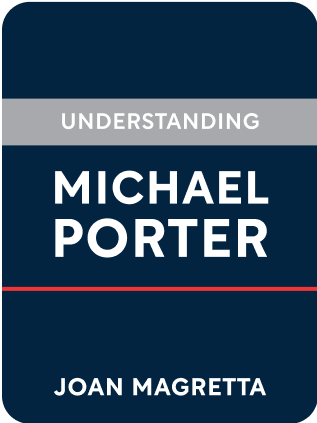

This article is an excerpt from the Shortform summary of "Understanding Michael Porter" by Joan Magretta. Shortform has the world's best summaries of books you should be reading.
Like this article? Sign up for a free trial here .
Michael Porter’s airline industry analysis uses the Five Forces model to dig into major airlines and why they’re so consistently unprofitable. Even though they have billions of dollars in revenues, they’re chronically bad businesses. Porter’s five forces analysis helps you understand why.
Case Study: Airline Industry Analysis
Michael Porter’s airline industry analysis is well-known. The airline industry has been one of the least profitable in the past decades. The Five Forces explain why:
- Suppliers – labor unions bargain for worker rights; plane makers are few and large
- Buyers are price sensitive, have low switching costs, and use the Internet to price compare.
- Generally buyers aren’t willing to pay for premium features like more comfortable seats or customer experience.
- The airline industry partially caused this – they practiced yield management, setting different prices for the same seat based on when someone bought a ticket. This may have seemed like smart price segmentation, but it trained customers to shop for prices.
- Rivalry among competitors is fierce. Empty seats are perishable goods, leading to price competition to make sure planes fly empty as little as possible.
- New entrants have a lower barrier than it seems – one can start an airline by leasing planes instead of buying them. Failed airlines have extra planes leading to excess capacity.
- Substitutes for travel like car, bus, and train keep prices down.
Steps in Industry Analysis
Like in the airline industry analysis, the Five Forces are used to study the profitability of any industry. Michael Porter outlines the process on how to apply them to analyze an industry.
1. Define the industry by its product scope and geographic scope.
- Rule of thumb: Where there are large differences in forces, you are likely dealing with distinct industries. Each industry will need its own strategy.
- Product scope
- Motor oil used in consumer cars is different from those used in trucks. The latter involve corporate buyers and use different selling channels.
- Geographic scope: global, national, regional
- Buyers may be very different across geographies, even with the same product.
2. Identify the players comprising each of the Five Forces. Segment them into groups (like in the five forces analysis of the airline industry)
3. Understand the drivers of each force. Which are strong? Which are weak? Why?
4. Step back and understand the industry as a whole.
- Which forces determine profitability? Rarely are all five forces equally balanced.
- Where are the more profitable companies positioned in relation to the Five Forces?
- How do your results measure up to the industry’s level of profitability?
5. Study recent changes and predict future changes for each force.
- How are the forces trending?
- How can your competitors influence industry structure and shift the Five Forces?
- Each of your Five Forces is its own industry. Within each industry represented by a force, how will competitors or new entrants change that industry’s structure? (For example, your substitute’s industry may face increased competition from incumbent rivalry.)
6. Where will you position yourself relative to the Five Forces? Where the forces are weakest? Where change will open new opportunities? Can you reshape the industry structure?
The point of Five Forces isn’t just to declare an industry attractive or unattractive; it’s also to gain insight about where industry profitability is and how it will change.
Practically for you, it also helps you understand your performance relative to the industry, and how you should overcome forces to capture more of the value you create.
Analogy: good strategies are shelters in a storm. Five Forces analysis forecasts the weather.
Points About Industry Structure
The five forces analysis of the airline industry is only one example. Industry structure is surprisingly stable over time, even with the introduction of new products and new technologies. New products are introduced and companies come and go, but the overall profitability of an industry changes relatively slowly. You can see this in the airline industry analysis.
The same company can require different strategies in different markets.
- In the US cement industry, large powerful buyers bargain for low prices. In Mexico, the majority of revenues come from small individual customers, served by large producers.
Leaders in an industry can shape the industry by leading competition away from price.
- For example, Sysco moved the basis of competition for food suppliers away from price and toward useful services, like private label to neutralize suppliers. They provided services like inventory management and nutrition planning. This shifted competition away from price alone, and the industry became more attractive.
Misleading Predictors of Profitability
Common perception correlates certain attributes of industries with profitability. For instance, high-tech industries seem large and profitable, and so people often associate technology with profitability.
Porter argues these associations are not predictive in themselves – rather, the changes need to be analyzed by their impact on the Five Forces. You can see this at work in the Five Forces analysis of the airline industry.
Examples of misleading associations include:
- High growth vs low growth
- Growth is no guarantee the industry will be profitable.
- All forces can change with growth. Growth might put suppliers in the driver’s seat, or new entrant competition becomes fierce before entry barriers are established.
- Technology
- Can raise costs if all competitors adopt it
- Can decrease profitability by increasing buyer power, for instance by enabling price shopping
- Regulation
- Should be mapped to Five Forces. The specific regulation can affect forces differently – it can increase the barrier to entry for new entrants (e.g. in regulation that requires licensing), or increase competition among rivals (e.g. in anti-trust regulation), or increase the bargaining power of suppliers (e.g. in regulation promoting workers’ rights).
The airline industry analysis in Understanding Michael Porter is a great use of the five forces model. The airline industry analysis is a massive business with lots of competition, and the five forces model can be used across other industries using this example.

———End of Preview———
Like what you just read? Read the rest of the world's best summary of Joan Magretta's "Understanding Michael Porter" at Shortform .
Here's what you'll find in our full Understanding Michael Porter summary :
- How Porter's famous Five Forces help you analyze every industry
- How IKEA, Southwest Airlines, and Zara have ironclad, defensible strategies
- Why the best companies reject opportunities to focus on what they know






